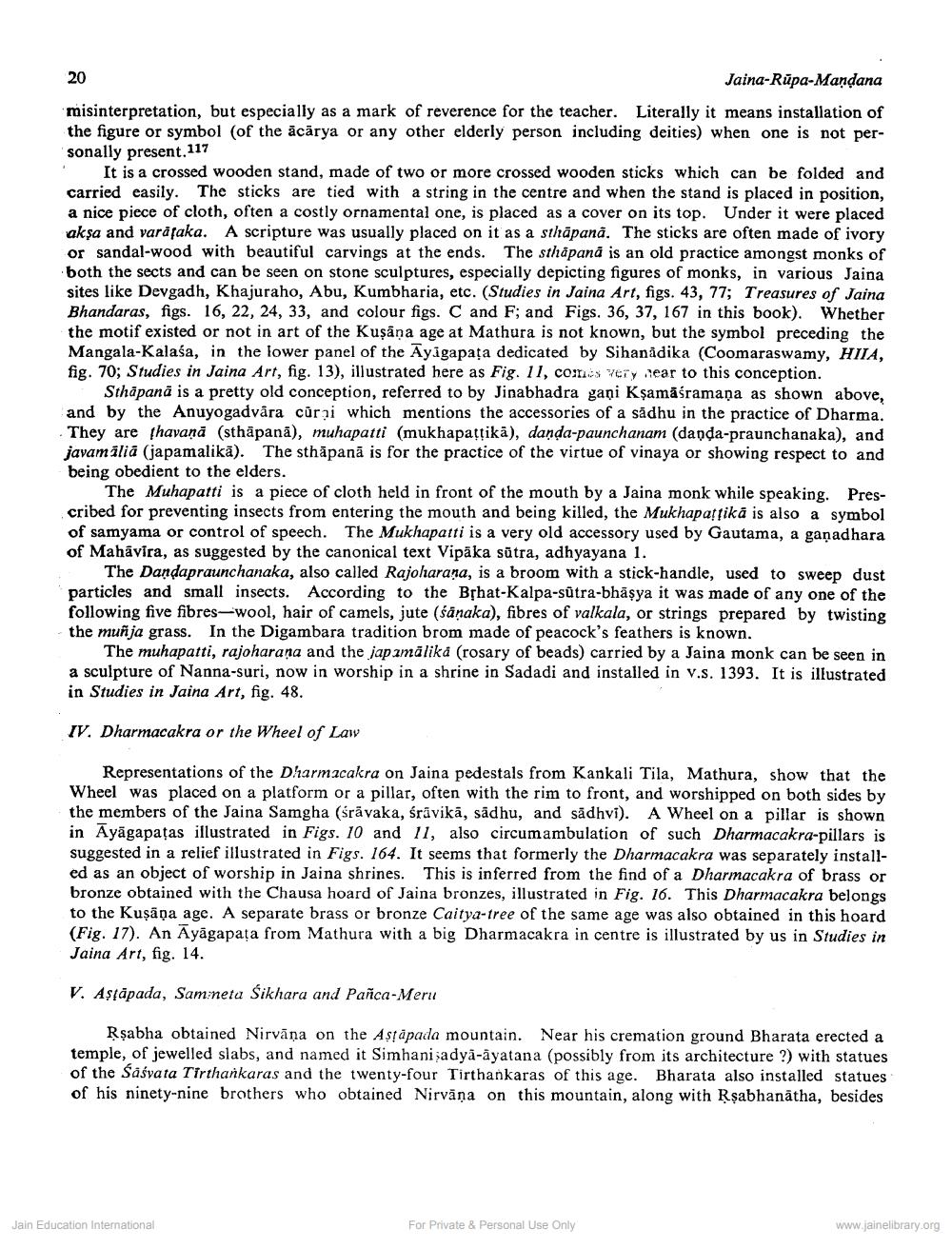________________
20
Jaina-Rupa-Mandana
misinterpretation, but especially as a mark of reverence for the teacher. Literally it means installation of the figure or symbol of the ācārya or any other elderly person including deities) when one is not personally present. 117
It is a crossed wooden stand, made of two or more crossed wooden sticks which can be folded and carried easily. The sticks are tied with a string in the centre and when the stand is placed in position, a nice piece of cloth, often a costly ornamental one, is placed as a cover on its top. Under it were placed akşa and varafaka. A scripture was usually placed on it as a sthāpanā. The sticks are often made of ivory or sandal-wood with beautiful carvings at the ends. The sthapana is an old practice amongst monks of both the sects and can be seen on stone sculptures, especially depicting figures of monks, in various Jaina sites like Devgadh, Khajuraho, Abu, Kumbharia, etc. (Studies in Jaina Art, figs. 43, 77; Treasures of Jaina Bhandaras, figs. 16, 22, 24, 33, and colour figs. C and F; and Figs. 36, 37, 167 in this book). Whether the motif existed or not in art of the Kuşāņa age at Mathura is not known, but the symbol preceding the Mangala-Kalaša, in the lower panel of the Ayagapata dedicated by Sihanädika (Coomaraswamy, HIIA, fig. 70; Studies in Jaina Art, fig. 13), illustrated here as Fig. 11, come very near to this conception.
Sthapana is a pretty old conception, referred to by Jinabhadra gani kşamāśramana as shown above, and by the Anuyogadvāra cūrai which mentions the accessories of a sådhu in the practice of Dharma.
They are thavanā (sthapana), muhapatti (mukhapattikā), danda-paunchanam (dapda-praunchanaka), and javamilia (japamalikā). The sthāpanā is for the practice of the virtue of vinaya or showing respect to and being obedient to the elders.
The Muhapatti is a piece of cloth held in front of the mouth by a Jaina monk while speaking. Prescribed for preventing insects from entering the mouth and being killed, the Mukhapatrika is also a symbol of samyama or control of speech. The Mukhapatti is a very old accessory used by Gautama, a gañadhara of Mahavira, as suggested by the canonical text Vipāka sūtra, adhyayana 1.
The Dandapraunchanaka, also called Rajoharana, is a broom with a stick-handle, used to sweep dust particles and small insects. According to the Bệhat-Kalpa-sútra-bhāşya it was made of any one of the following five fibres-wool, hair of camels, jute (sanaka), fibres of valkala, or strings prepared by twisting the muñja grass. In the Digambara tradition brom made of peacock's feathers is known.
The muhapatti, rajoharana and the jap amalika (rosary of beads) carried by a Jaina monk can be seen in a sculpture of Nanna-suri, now in worship in a shrine in Sadadi and installed in V.s. 1393. It is illustrated in Studies in Jaina Art, fig. 48.
IV. Dharmacakra or the Wheel of Law
Representations of the Dharmacakra on Jaina pedestals from Kankali Tila, Mathura, show that the Wheel was placed on a platform or a pillar, often with the rim to front, and worshipped on both sides by the members of the Jaina Samgha (śrävaka, śravikā, sādhu, and sadhvi). A Wheel on a pillar is shown in Ayāgapațas illustrated in Figs. 10 and 11, also circumambulation of such Dharmacakra-pillars is suggested in a relief illustrated in Figs. 164. It seems that formerly the Dharmacakra was separately installed as an object of worship in Jaina shrines. This is inferred from the find of a Dharmacakra of brass or bronze obtained with the Chausa hoard of Jaina bronzes, illustrated in Fig. 16. This Dharmacakra belongs to the Kuşaņa age. A separate brass or bronze Caitya-tree of the same age was also obtained in this hoard (Fig. 17). An Ayagapata from Mathura with a big Dharmacakra in centre is illustrated by us in Studies in Jaina Art, fig. 14.
V. Aştāpada, Sam:neta śikhara and Panca-Meru
Rşabha obtained Nirvāṇa on the Astăpada mountain. Near his cremation ground Bharata erected a temple, of jewelled slabs, and named it Simhanizadya-ayatana (possibly from its architecture ?) with statues of the Saśvata Tirthankaras and the twenty-four Tirthankaras of this age. Bharata also installed statues of his ninety-nine brothers who obtained Nirvāņa on this mountain, along with Rşabhanātha, besides
Jain Education International
For Private & Personal Use Only
www.jainelibrary.org




